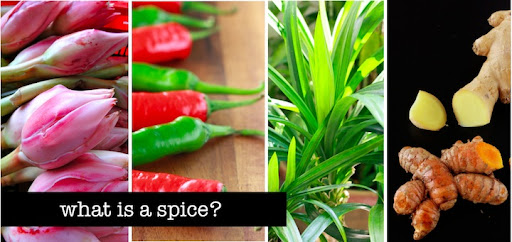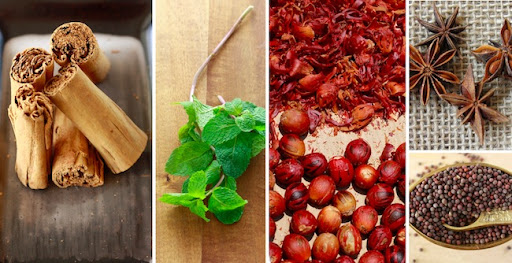A flavor that burns your mouth like chili peppers? Or does it need to be dried, and ground, to be called a spice, like ginger or garlic powder? Does a spice need to color your food like turmeric and paprika? Or originate from a tropical region like cloves and curry leaves do? Is it a seed, like a peanut or nutmeg? A leaf like basil or pandan? A fruit like peppercorn or lemon?
In the Oxford Dictionary, the definition of a spice is an aromatic or pungent vegetable substance used to flavour food, e.g. cloves, pepper, or cumin
The examples are helpful, but the definition leads to more questions, than answers.
What does the culinary world think? The Food Lover’s Companion states that a spice is a pungent or aromatic seasonings obtained from the bark, buds, fruit, roots, seeds or stems of various plants and trees (whereas herbs usually come from the leafy part of a plant).
That’s not an official definition, but it is a narrower one, distinguishing a spice and an herb. But does that mean that ground peanuts are a spice because peanuts are seeds, and the oil of the peanut flavors food? What about dried fruits like cranberries and blueberries that are ground up?
In the US, the Food and Drug Administration (FDA) defines a spice as any aromatic vegetable substance in the whole, broken, ground form except for those substances that have been traditionally regarded as foods, such as onions, garlic, and celery; whose significant function in food is seasoning rather than nutrition.
Well, that adds herbs back in as a spice.
The American Spice Trade Association (ASTA) must have the decisive answer. They define a spice as any dried plant product used primarily for seasoning purposes.
That’s even more general than the dictionary, and now throws vegetable seasonings - like garlic and onion powder - back into the mix.
What is clear in these hazy meanings is that everyone defines spices differently. That’s why there is not an official list of spices. Throughout history the meaning has changed, and it continues to evolve based on the flavors we cook with – how we season our food - and that varies from place to place and from culture to culture.
Let’s try this again - What is a spice?
On Season with Spice, we accept that ‘spice’ has many meanings. Yes, we agree with the distinction between spices and herbs that is stated in The Food Lover’s Companion, but we also see ‘spice’ as a broader term as the dictionary definition alludes to.
When anyone takes that first spoonful of bland food, and blurts out, “Needs some spice,” they are craving more flavor, whether it’s a spice in the traditional sense, or an herb. Because leafy herbs are a flavoring; a seasoning; a spice.
Therefore, our definition of a spice follows closely to the US FDA description, which we summarize in three questions:
1. Does it meet the official definition of a spice, i.e. is it from a plant, and used to flavor food?
If yes, go to question #2 -
2. Is it considered a vegetable (e.g. onion, garlic, shallots)?
If no, go to question #3 -
3. Would you normally eat it by itself, i.e. is it considered a food (e.g. peanuts, oranges)?
If no, then congratulations, you have a spice! Whether it’s fresh or dried, whole or ground, it is a spice on Season with Spice.


